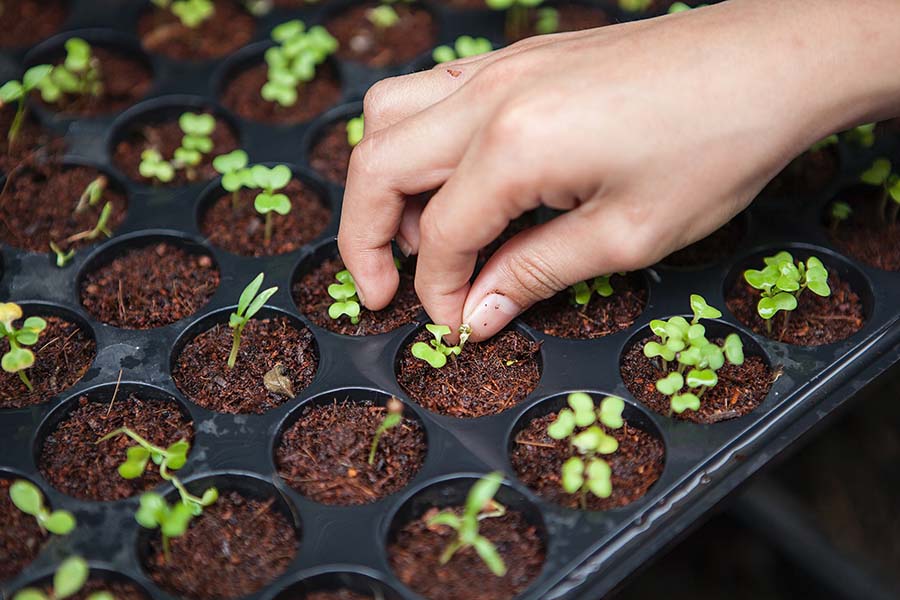Greening Cities: Vertical Farming’s Sustainable Solution

Vertical farming is revolutionising the way we think about traditional agriculture. With urban expansion and limited land availability, innovative techniques like vertical farming offer a sustainable solution to grow food in small spaces. This article explores the concept of vertical farming, its benefits, and the various techniques used to maximise productivity.
What is Vertical Farming?
Vertical farming uses controlled environments to grow crops in vertically stacked layers or vertically inclined surfaces. This technique utilises indoor spaces such as warehouses, skyscrapers, or shipping containers to create multiple layers for cultivating plants. By harnessing artificial lighting, climate control systems, and soilless growing mediums, vertical farming allows for year-round production of fresh, nutritious crops.
Benefits of Vertical Farming
Vertical farming offers numerous advantages over traditional agriculture methods:
Optimal Space Utilisation: Vertical farming maximises land use efficiency by vertically stacking crops, increasing the production capacity per square foot of land. This means that even in areas with limited space, such as urban environments, a significant amount of food can be grown.
By utilising vertical space, vertical farming makes it possible to grow crops in areas with limited horizontal land availability.
Vertical farming also allows for the efficient use of existing structures, such as empty warehouses or buildings, minimising the need for new construction.
Year-round Production: With controlled environments, vertical farms can grow crops irrespective of seasonal limitations, ensuring a consistent fresh produce supply throughout the year. This eliminates the dependence on specific growing seasons and reduces the risk of crop failures due to adverse weather conditions.
By controlling factors such as temperature, humidity, and light, vertical farms create ideal conditions for plant growth, enabling year-round production.
This continuous production helps meet the increasing demand for fresh, locally grown food, regardless of the time of year.
Reduced Water Usage: Vertical farms employ hydroponics or aeroponics systems, which use significantly less water than traditional soil-based agriculture. This reduction in water consumption makes vertical farming more sustainable and environmentally friendly.
Hydroponics, for example, allows for the precise delivery of water directly to the plant roots, minimising wastage.
The closed-loop systems used in vertical farming also enable the recycling and reuse of water, further reducing overall water consumption.
Enhanced Crop Quality: The controlled environments in vertical farms enable precise monitoring of temperature, humidity, and lighting conditions, resulting in higher crop yields and improved nutritional content.
By providing optimal growing conditions, vertical farming can lead to increased crop productivity and quality.
The ability to control environmental factors also allows farmers to customise growing conditions for specific crops, resulting in improved taste, texture, and nutritional value.
Reduced Transportation Costs: By establishing vertical farms in urban areas, the need for long-distance transportation of produce is minimised, reducing carbon footprints and costs associated with transportation.
Urban vertical farms can be located close to consumers, reducing the distance travelled by food from farm to table.
This localised production not only reduces transportation costs but also contributes to the freshness and overall quality of the produce.
Protection from External Factors: Urban vertical farms are shielded from pests, diseases, and extreme weather conditions, ensuring a more stable and secure food production system.
By growing crops indoors, vertical farms eliminate the risk of damage caused by pests and diseases commonly found in traditional agriculture.
Controlled environments also protect crops from extreme weather events, such as droughts or heavy rains, which can negatively impact crop yields.
Techniques Used in Vertical Farming
Vertical farming employs various techniques to optimise plant growth and maximise productivity. Some of these techniques include:
Hydroponics
Hydroponics is a soilless cultivation method that involves growing plants in nutrient-rich water solutions. The plants are typically suspended in a growing medium like perlite, coconut coir, or rock wool, allowing their roots to absorb nutrients directly from the water. This technique ensures efficient nutrient uptake, faster growth rates, and reduced water usage.
In hydroponic systems, the nutrient-rich water is continuously circulated, providing a constant supply of essential elements for plant growth.
This technique allows for precise control over nutrient levels, pH, and water availability, resulting in optimal plant growth and increased crop yields.
Hydroponics also eliminates the need for soil, reducing the risk of soil-borne diseases and pests.
Aeroponics
Aeroponics is a technique that involves growing plants in an air or mist environment without using soil or any other growing medium. Plant roots are suspended in the air and are periodically misted with a nutrient-rich solution. This method promotes rapid growth rates, efficient nutrient absorption, and minimises water usage.
In aeroponic systems, plant roots are exposed to air, allowing for increased oxygenation and nutrient absorption.
By misting the roots with a nutrient solution, plants receive a highly oxygenated and precisely dosed supply of nutrients.
The absence of a growing medium in aeroponics eliminates the risk of soil-borne diseases and provides plants unrestricted access to oxygen, resulting in faster growth and healthier plants.
Vertical Aquaponics
Vertical aquaponics combines hydroponics with aquaculture, creating a symbiotic relationship between plants and aquatic animals. In this system, fish waste provides nutrients to the plants while the plants filter and purify the water for the fish. This mutually beneficial interaction creates a sustainable and eco-friendly farming system.
In a vertical aquaponics system, fish are reared in tanks, and their waste is converted into plant nutrients.
The plants, in turn, absorb these nutrients, effectively filtering and purifying the water for the fish, creating a closed-loop system.
This integrated approach reduces the need for external fertilisers and minimises water usage, making it a highly sustainable farming technique.
Tower Gardens
Tower gardens are vertical structures that allow plants to grow in a vertical column. These towers typically have multiple tiers or shelves, each housing several plants. The towers incorporate hydroponic or aeroponic systems, providing plants with the necessary water and nutrients. Tower gardens are often used in small-scale urban farming due to their space-saving design.
Tower gardens maximise vertical space utilisation by allowing plants to grow upwards, making them ideal for small spaces.
The compact design of tower gardens enables the cultivating of many plants in a limited area.
These systems are also easily scalable, making them suitable for home gardening and commercial farming.
Green Walls
Green walls, or living or vertical gardens, are vegetation-covered vertical structures. These walls use modular panels or containers to support plants grown using hydroponic or soil-based techniques. Green walls enhance aesthetics, improve air quality, and provide insulation.
Green walls are natural air purifiers, filtering pollutants and improving indoor air quality.
The vegetation on green walls helps regulate temperature and humidity, reducing energy consumption for heating and cooling.
These living walls also contribute to biodiversity, providing habitats for insects and birds in urban environments.
Conclusion
Vertical farming represents an innovative and sustainable approach to urban agriculture. Urban farmers can produce fresh, nutritious crops in limited spaces by utilising space-efficient techniques like hydroponics, aeroponics, vertical aquaponics, tower gardens, and green walls. The benefits of vertical farming, including optimal land use, year-round production, reduced water consumption, enhanced crop quality, and reduced transportation costs, make it a promising solution to address the challenges of food security and sustainability in urban areas.
If you found this post engaging, don’t forget to explore our additional blogs below.
- Zoom-Ready Fashion: Must-Have Styles for Virtual Meetings!
- Jet-Setter Must-Haves: Fashionable Travel Essentials!
- Unlock Wealth Secrets: Rich Dad Poor Dad Reveals All!
- Unleash Your Earning Potential: Mastering the Gig Economy Game!
- Unlock Your Peak Performance: Fast This Way with Dave Asprey!
- Revolutionise Your Kitchen: Master Zero-Waste Cooking Magic!
- Wild Adventures and Hilarious Mishaps: Bill Bryson’s Appalachian Trail Tale!
- Mastering AutoML: Perks, Uses & Hurdles Uncovered
- Love Unveiled: Cracking the Code of Relationships with John Gray!
- Unlocking Forever: Master the Secrets to Relationship Bliss!
Sign up for updates on this blog and our latest posts if you enjoyed reading this one.
Help your friends and colleagues stay informed about the newest insights on business, marketing, finance, lifestyle, and society by sharing our blog content through Facebook, Twitter, Pinterest, LinkedIn, email, or WhatsApp links below. We can create a knowledge-sharing community and empower one another to accomplish and experience our objectives.
FAQ
What is vertical farming?
Vertical farming uses controlled environments to grow crops in vertically stacked layers or vertically inclined surfaces. It utilises indoor spaces such as warehouses, skyscrapers, or shipping containers to create multiple layers for cultivating plants.
What are the benefits of vertical farming?
Vertical farming offers several advantages over traditional agriculture methods. These benefits include optimal space utilisation, year-round production, reduced water usage, enhanced crop quality, and reduced transportation costs.
What techniques are used in vertical farming?
Vertical farming employs various techniques to optimise plant growth and maximise productivity. These techniques include hydroponics, aeroponics, vertical aquaponics, tower gardens, and green walls.
What is hydroponics?
Hydroponics is a soilless cultivation method that involves growing plants in nutrient-rich water solutions. The plants are typically suspended in a growing medium like perlite, coconut coir, or rock wool, allowing their roots to absorb nutrients directly from the water. This technique ensures efficient nutrient uptake, faster growth rates, and reduced water usage.
Credits
Featured photo by Joshua Lanzarini on Unsplash.









